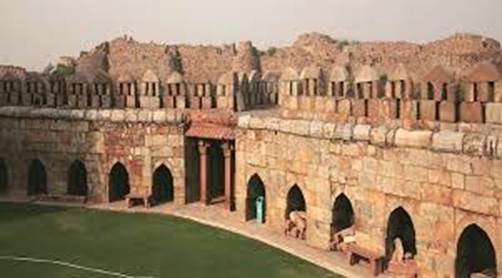Historical Significance
- Built in 1320 AD by Ghiyasuddin Tughlaq, founder of the Tughlaq dynasty.
- Designed as a military fortress to repel Mongol invasions.
- Served briefly as the capital under Ghiyasuddin before being abandoned after the capital shifted to Daulatabad under Muhammad bin Tughlaq.
Relevance : GS 1(Culture ,History and Heritage)

Architectural and Strategic Genius
- Located in the Aravalli hills — built into the natural terrain.
- Featured:
- 15-metre-high walls
- Granaries, escape tunnels, water reservoirs
- Multiple defensive perimeters with surrounding water bodies.
- Considered more militarily sound than even the Red Fort or Agra Fort, according to historian SM Azizuddin Husain.
Cultural and Spiritual Dimensions
- Site of a historicmehfil where Hazrat Nizamuddin Auliya defended the practice of Sama (spiritual music).
- Resulted in qawwali being formally accepted in the Indian Sufi tradition.
- Symbolisestensions between spiritual and political authority:
- Sultan Ghiyasuddin vs. Sufi saint Nizamuddin Auliya.
- Saint’s “curse” (“May it remain desolate”) allegedly followed the Sultan’s diversion of labour from the saint’s baoli.
Debunking the “Curse”
- Historians argue:
- No factual basis for the “curse” — legends grew later to explain abandonment.
- Abandonment linked to political irrelevance, not supernatural punishment.
- Ghiyasuddin’s death in a pavilion collapse post-Bengal campaign fuelled myth-making, but could also reflect political intrigue.
Myth vs Reality: Governance Implications
- Heritage activist Sohail Hashmi:
- Myths distract from its real political and architectural value.
- Tughlaqabad should be viewed as a “classroom under the sky”.
- Current under-visited state contrasts with monuments like Qutub Minar or Red Fort.
- Reflects heritage management challenges:
- Lack of interpretation centres, tourism promotion, community engagement.
Retrospective Linkages
- Tughlaq architectural style: Fort reflects early Indo-Islamic military architecture.
- Nizamuddin Auliya’s role: Integral to Delhi’s spiritual history; represents Sufi influence on Indian syncretism.
- Urban planning under the Delhi Sultanate: Tughlaqabad was part of the third historic city of Delhi.
Cultural Policy Lessons
- Reviving Tughlaqabad:
- Can be integrated into Delhi’s heritage tourism circuit.
- Use of digital reconstruction, AR/VR, and guided trails.
- Curricular inclusion:
- Fort can serve as a pedagogical site to teach military history, Sufism, urban planning.
- Need for better ASI funding and multi-stakeholder conservation models.
- Countering ‘curse narratives’ with historical literacy and community storytelling.



